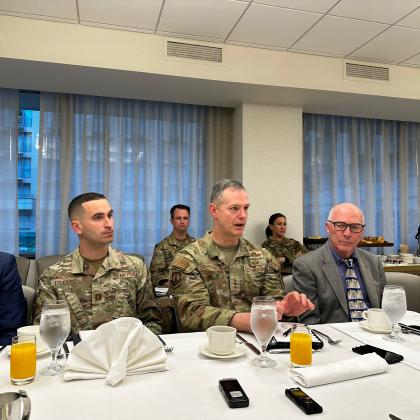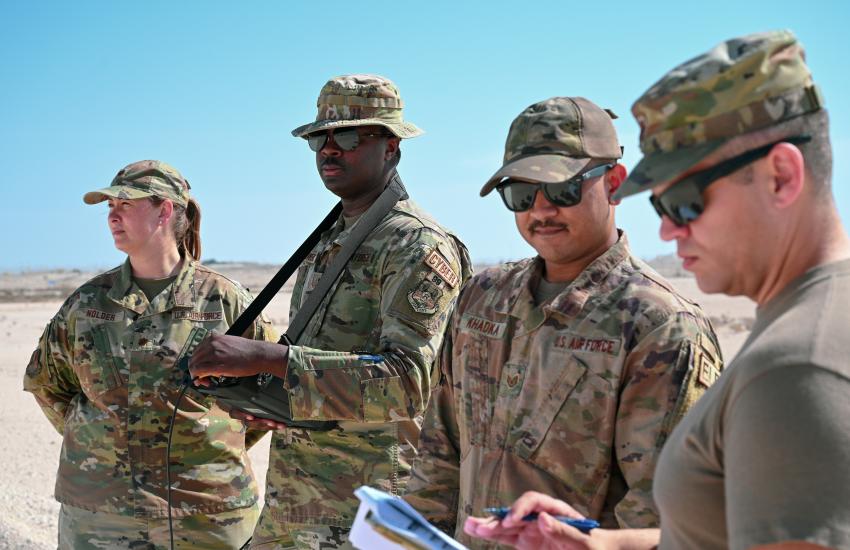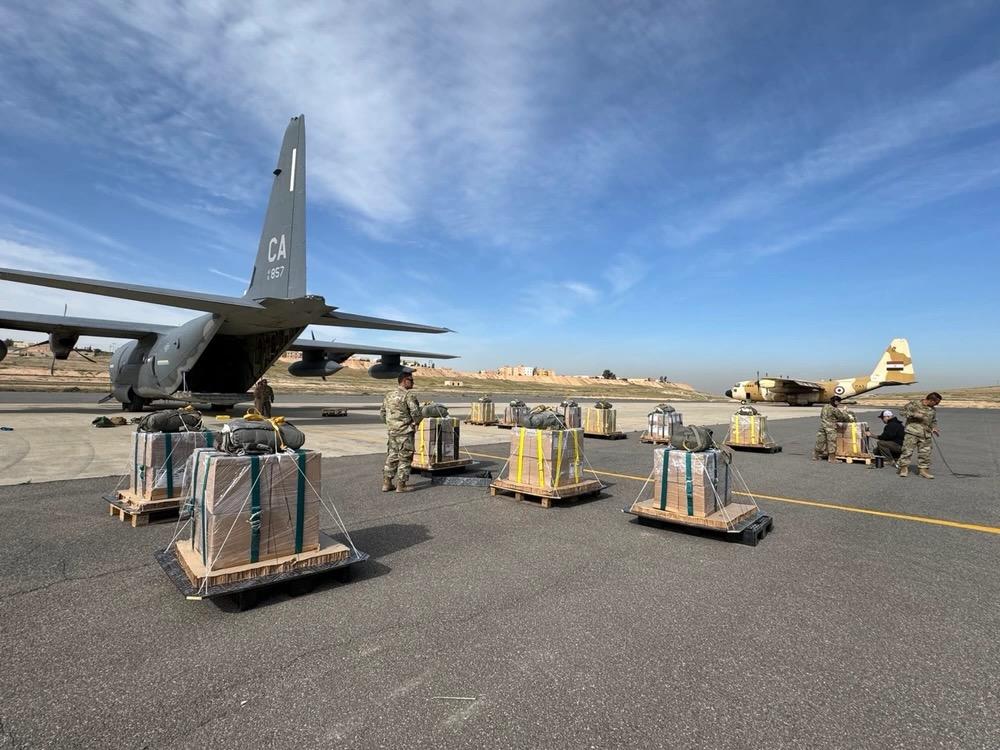ISR Continues To Illuminate Operations in the Middle East
Intelligence, surveillance and reconnaissance (ISR) capabilities continue to be key to operations in the Middle East, said Lt. Gen. Alexus Grynkewich, commander, Ninth Air Force/Air Forces Central (AFCENT), Shaw Air Force Base, South Carolina, and commander, Combined Forces Air Component for U.S. Central Command (CENTCOM), Southwest Asia. AFCENT, which needs more ISR in certain areas—such as Yemen—and wants further innovations, is tackling that head-on.
“I've hinted that more ISR is always better—you have probably never heard a commander say, ‘Oh, I've got too much ISR; I'll send it back,’” Gen. Grynkewich stated. “More ISR is always better. It is always a challenge to penetrate and especially difficult to build institutional understanding of something you have not looked at. And we see that even in AFCENT ourselves. That’s not a broader criticism at all, but just internal. We haven't looked at Yemen in a while. So we have had to build that expertise very quickly.”
The commander spoke to reporters during a Defense Writers Group meeting on April 3 in Washington, D.C.
The demands on AFCENT and the other components supporting CENTCOM have naturally increased since the October 7 attacks of Hamas on Israel. Before then, AFCENT’s mission in the area of responsibility (AOR) had been evolving from its 20-plus-year nexus supporting the U.S. counterterrorism mission and military operations in Afghanistan, Iraq and other countries to then supporting the Great Power Competition mission laid out by the U.S. National Defense Strategy.
The region continues to be a complex operating environment, with partner nations and the U.S. military working to prevent a further escalation of war or conflict, the commander emphasized.
The United States is seeing attacks from militia groups backed by Iran on coalition and U.S. forces in Iraq and Syria, the Hamas/Israeli war in Gaza, Iran-backed Houthis in Yemen attacking, including in the Red Sea region and disrupting shipping lanes, and Hezbollah activity in Lebanon, among other actions.
“After the seventh of October, our priorities did rapidly shift to focus on the emerging crisis,” Gen. Grynkewich stated. “Our objective was really to contain the conflict between Hamas and Israel and to deter [other] malign actors from taking advantage of the situation, to the extent that we could, and then to prevent it from escalating across the region. We were successful in some areas, and not in others. About 170 attacks—and a few more than that on our forces in Iraq and Syria—in the post-October 7 era.”
Following the January 28 attacks on U.S. forces by Iran-backed militia groups that killed three U.S. soldiers and injured many more in Jordan, the United States’ military response has been able to “reset deterrence,” Gen. Grynkewich said, to where they have not seen any subsequent Iranian-backed militia strikes since then.
“It was both the volume of the targets—I think we had over 85 targets—and it was what those targets were,” he explained. “Some things were militia-related targets, but there were others that were IRGC-related [The Islamic Revolutionary Guard Corps-related] targets. And so, it sent a very clear signal, I think, to the Iranians that they had crossed the line with the death of our American soldiers from Tower 22 and their support to the militias in those attacks. And that is what reset deterrence . . . Deterrence, of course, is always a temporal, cognitive effect. So we're watching it closely, keeping an eye on the intel [intelligence] and making sure that deterrence is holding.”
The U.S. military will continue to watch Iran-backed Houthi activity in Yemen closely, the commander stated. “Down in Yemen, a lot of focus on the Houthis and the threat that they represent to regional stability as well for us,” he said. “That's been a significant priority. 75 missiles, cruise missiles, anti-ship ballistic missiles that they've launched since they started attacking back in the November timeframe—over 50 attacks and 55 different countries affected by this.”
AFCENT conducts self-defense air strikes on behalf of CENTCOM. AFCENT’s role and priority is to degrade and attrit the Houthi capabilities, especially those that threaten shipping lanes in the Red Sea—an area that hosts about 15% of global sea trade. Moreover, the Houthis are exploiting the turbulent situation in the region for their own ends, Gen. Grynkewich said.
“Their narrative is that this is about Israel and Gaza and the Palestinians, but they haven't supplied a single loaf of bread to help with the humanitarian crisis in Gaza,” the commander emphasized. “To me, this is really about the Houthis wanting to build their own notoriety and their own power base, if you will, and nothing to do with the situation in Gaza.”
Additionally, AFCENT has flown 21 airdrop missions between March 2 and April 3, dropping food and supplies to refugees in Gaza.
All these efforts naturally require robust ISR capabilities, Gen. Grynkewich stated. The Air Force is flying a combination of ISR aircraft, which help support the service’s adroit pre-emptive strikes, such as taking out Houthi missile launchers.
“We have a layered ISR collection strategy, and there's been a lot of priority put on Yemen at the national level and at the component level and at the CENTCOM level,” the commander said. “And we are rapidly ingesting any imagery that we get from national sources. We are supplementing that with an airborne layer of ISR. We are flying MQ-9s in the Southern Red Sea. And so that's a layer. And of course, there's all the other [intelligence] that we put on top of that, but I won't go into details.”
To support the Air Operations Center, a “dynamic cell” of personnel fuses the ISR data and information quickly, which then goes into AFCENT’s battle management command and control network—the architecture of which includes aircraft as well as ships.
“As tipping and cuing comes in, we can even rapidly re-task assets to go take a closer look,” Gen. Grynkewich offered. “We are looking for the telltale signs that something is set up, something's on a launch or something's ready to go. Sometimes that's backed up by other intelligence that [allows us] to understand some of the intent behind what we might be seeing.”
In addition, to improve operations, the CENTCOM air service component wants to pull in more innovation to find new ways to solve the “sticky, enduring and more proximate problems.” For example: finding additional ways to see or find possible Houthi capabilities that threaten Red Sea shipping.

We have a layered ISR collection strategy, and there's been a lot of priority put on Yemen at the national level and at the component level and at the CENTCOM [U.S. Central Command] level.
For this, AFCENT is leaning on its 2022-built Task Force 99, a group within the service component at the combatant command that is leveraging digital and unmanned technologies. The group collaborates with the U.S. Navy’s Task Force 59 officials positioned at CENTCOM, as well as the Army’s Task Force 39. The Air Force’s effort under Task Force 99 now also includes almost 20 partner nations.
“Our Task Force 99 continues to evaluate and experiment and work toward fielding of actual capabilities that could do additional intelligence, surveillance and reconnaissance work,” he stated.
The quest for a tactically effective mixture of airborne-related ISR capabilities does involve a lot of trade-offs, the commander noted. “The inventory of unmanned aerial vehicles that we have right now, MQ-9s, MQ-1s and Scan Eagles, they all come with different price points and with different capabilities and there's a trade-off,” Gen. Grynkewich noted. “There's more expensive, more exquisite, less expensive, less exquisite.”
As such, Task Force 99 is “finding a way to thread the needle,” balancing between reliance on commercial-off-the-shelf technologies and in-house technologies that have more capabilities. And ideally, such solutions would not cost as much and could be expendable.
“Task Force 99 is working that very hard right now,” the commander said. “They have a couple of promising technologies. I won’t get into exactly what they are. But we're in general, the task I've given them is I need them to figure out a way to flood the zone with additional intelligence, surveillance and reconnaissance, so we can identify these threats to the maritime domain faster, better, cheaper than we can right now. And they are getting really close.”
The solutions would be applied to operations involving Yemen, as well as elsewhere. The commander confirmed that AFCENT had already been using some of the innovative capabilities in combat operations in the AOR.
Lastly, the commander sees the Great Power mission as applicable to the CENTCOM AOR.
“There is one priority that has not changed,” Gen. Grynkewich stated. “We certainly see the [CENTCOM] region as central to strategic competition. That has become more and more clear in the current crisis, as you see the confluence of not only the Chinese trying to undermine our position as a security integrator and undermine our relationships with partners in the region. But you see the confluence of China with Russia and Iran, and the Iranian supplies to Russia, the collusion, the tech transfer that's going back and forth. That's something that is, I think, a major feature that has emerged even more strongly. I spoke last time that I was worried about that growing Iranian and Russian collusion, and I think we're seeing it in spades now.”
Gen. Grynkewich has a few months left in his position at AFCENT and CENTCOM. After that, he will move to the Joint Chiefs of Staff to be the J3, director of operations.





Comments